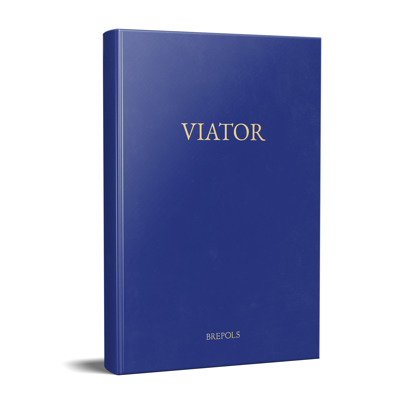
Viator 38, No. 2 (2007)
- Pages: 398 p.
- Size:175 x 255 mm
- Illustrations:34 b/w
- Language(s):English
- Publication Year:2007
- € 62,00 EXCL. VAT RETAIL PRICE
- ISBN: 978-2-503-52481-8
- Hardback
- Out of Print
- E-journal
- Available
Giles Constable, ‘Medieval Latin Metaphors’;
Brian Noell, ‘Scholarship and Activism at Cîteaux in the Age of Innocent III’;
Tracy Adams, ‘Performing the Medieval Art of Love: Medieval Theories of the Emotions and the Social Logic of the Roman de la Rose of Guillaume de Lorris’;
James McEvoy and Michael Dunne, ‘A Pseudo-Grosseteste Treatise on Luxuria at Pavia’;
Kate Dimitrova, ‘Class, Sex, and the Other: The Representation of Peasants in Set of Late Medieval Tapestries’;
Michaela Paasche Grudin, ‘Making War on the Widow: Boccaccio’s Il Corbaccio and Florentine Liberty’;
Ian Christopher Levy, ‘John Wyclif and the Primitive Papacy’;
Karen Elizabeth Gross, ‘Hunting, Heraldry, and the Fall in the Boke of St. Albans’;
Michael Van Dussen, ‘Conveying Heresy: ‘A Certayne Student’ and the Lollard-Hussite Fellowship’;
Guendalina Ajello Mahler, ‘Ut Pictura Convivia: Heavenly Banquets and Infernal Feasts in Renaissance Italy’;
Holt N. Parker, ‘The Magnificence of Learned Women’;
Eric Rice, ‘Two Liturgical Responses to the Protestant Reformation at the Collegiate Church of Saint Mary in Aachen, 1570–1580’;
The Theory and Practice of Friendship in the Middle Ages:
Courtney DeMayo, ‘Ciceronian Amicitia in the Letters of Gerbert of Aurillac’;
Rebecca L. Slitt, ‘Justifying Cross-Cultural Friendship: Bohemond, Firuz, and the Fall of Antioch’;
H. M. Canatella, ‘Friendship in Anselm of Canterbury’s Correspondence: Ideals and Experience’;
Constant J. Mews, ‘Cicero and the Boundaries of Friendship in the Twelfth Century’;
Cary J. Nederman, ‘Friendship in Public Life during the Twelfth Century: Theory and Practice in the Writings of John of Salisbury’.

